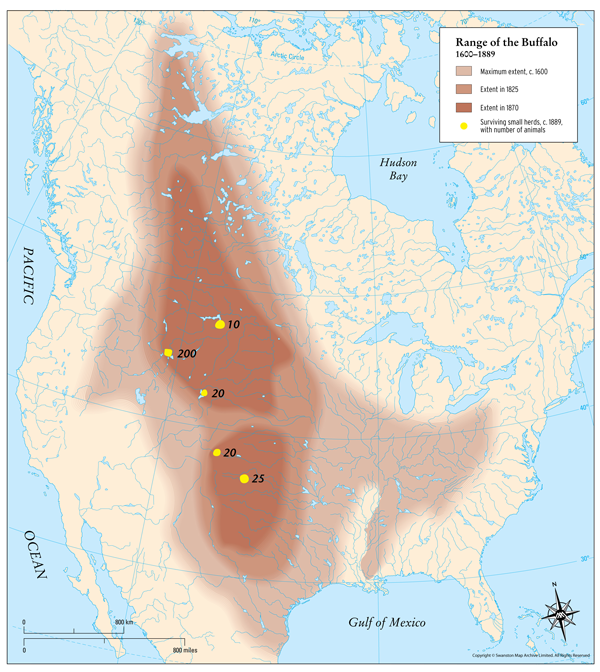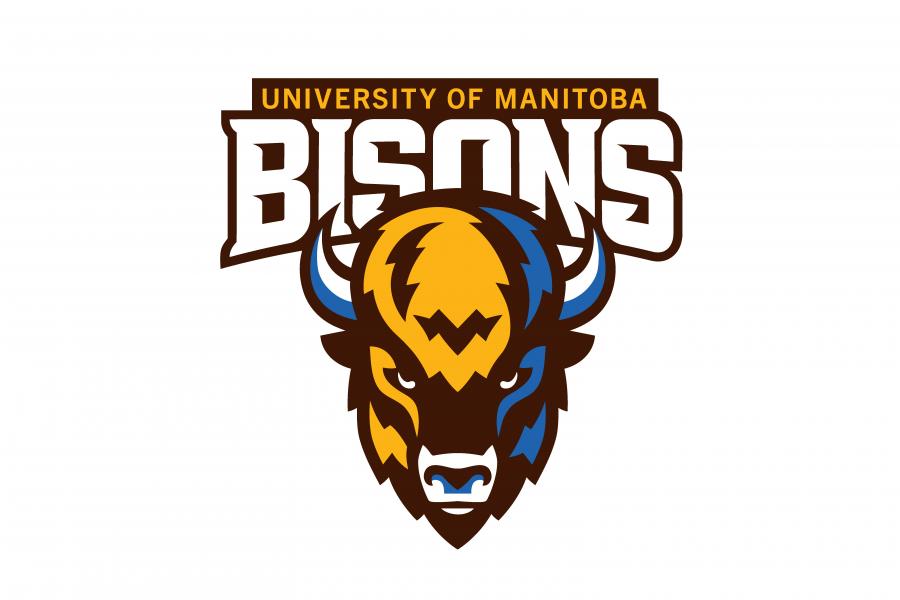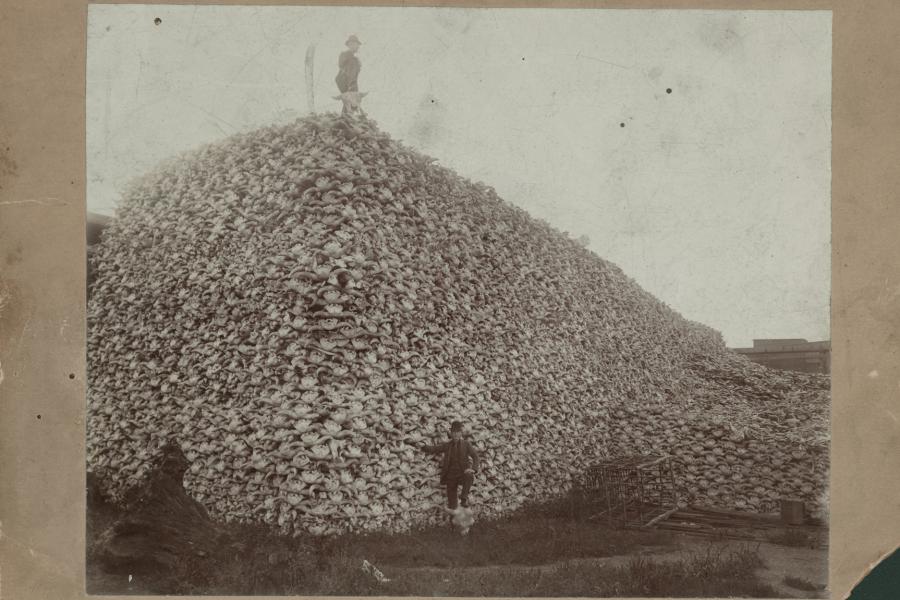The Spirit of the Bison
The University of Manitoba aspires to and embraces the spirit of the bison. This strong, swift, hardy being lives as part of a herd once so large it covered the horizon, and the sound of their hooves striking the earth sounded like the thunder of the frequent storms that give life to the plains. Bison are the largest North American land mammal weighing up to 2,200 pounds at maturity and living up to twenty years. Showing great loyalty and working together as one to protect and serve even its youngest and weakest members against ferocious adversaries, bison survived and thrived in their millions on the rich abundance the tall-grass prairies of the plains provided, and their manure created the rich soils our province’s farmers still benefit from. Hunted in Manitoba by Cree, Assiniboine, Dakota, Dene, Inuit, Oji-Cree and Anishinaabe alike, many Indigenous communities in Manitoba revered the bison recognizing that one as a relative and one who gives its life for the survival of the people.
Read more
The University of Manitoba aspires to and embraces the spirit of the bison. This strong, swift, hardy being lives as part of a herd once so large it covered the horizon, and the sound of their hooves striking the earth sounded like the thunder of the frequent storms that give life to the plains. Bison are the largest North American land mammal weighing up to 2,200 pounds at maturity and living up to twenty years. Showing great loyalty and working together as one to protect and serve even its youngest and weakest members against ferocious adversaries, bison survived and thrived in their millions on the rich abundance the tall-grass prairies of the plains provided, and their manure created the rich soils our province’s farmers still benefit from. Hunted in Manitoba by Cree, Assiniboine, Dakota, Dene, Inuit, Oji-Cree and Anishinaabe alike, many Indigenous communities in Manitoba revered the bison recognizing that one as a relative and one who gives its life for the survival of the people.
In Indigenous traditions, Buffalo represent Respect for its willingness to give every part of its being to sustain the lives of others not because he values himself less, but because he respects the balance and needs of others. Not only was the Bison prized for its meat which was dried and preserved for use throughout the year, but with the thickest hide of any North American animal, its skins were used for shelter, for hulls of rivercraft, for clothing and for warrior’s shields, its bones and sinews used for tools such as the implements used in Indigenous agriculture and other every-day activities. That said, prior to European arrival, as Indigenous people did not have horses or guns, bison were hunted more seasonally when their migrations brought the animals near agrarian communities. Indigenous people hunted them with spears in large groups on foot.
Horses first became traded among Indigenous nations after the Pueblo Revolt took place in 1680 in what is today modern day New Mexico. While the Pueblo people asked the Spaniards to leave, they kept their animals. The horse was gradually traded further and further north and was almost immediately adapted to bison hunting. The horse first became common among Manitoba Indigenous communities between 1750 and 1770. Guns used in hunting bison, however, came from the east through both the French and English fur trade. Bison were enormously important to the trade for its fat used to make the pemmican that fed the employees of the fur trade and allowed it to thrive. Métis families took to organizing large scale buffalo hunts, particularly during the period of competition between the HBC and NWC between 1780 and 1821. Métis political organization originates in these buffalo hunts that mobilized as many as two thousand Métis warriors at a time.
 Photo by Range of the Buffalo 1660-1889 Map Code: Ax01502
Photo by Range of the Buffalo 1660-1889 Map Code: Ax01502
Courtesy The Map Archive
Today the Bison are much diminished in number due to a variety of historical forces. As industrialization moved onward across the 19th century, machine belts were at first made from leather, and no hide in North America was as thick and durable as that of the buffalo. The wagon trails established for settlers to travel west created wide muddy areas across which the bison could neither see nor smell food changing their expected migration routes. Further, their enormous herds were seen as a hinderance to transcontinental rail traffic, causing railway companies to hire hunters to diminish the herds and even shoot bison from the train itself. As the plains were settled, the tallgrass prairies with their 3-5 foot root systems that sustained the bison were plowed up and replaced with crops like wheat that had much shallower hold on the soil contributing to the plains region becoming a “dust bowl” of blowing soil in the 1930s. The strange new plants and the fences that protected them also created obstacles for the survival of bison herds. In addition to these market forces, settler state policies for Indigenous people also impacted the bison. US General Sheridan of Civil War fame who was assigned to “pacify the plains” following that conflict famously supported buffalo hunters in order to force plains Indigenous nations into a submission that would require them to be dependent on the US government who could then limit their movements. One US army colonel in 1867 told a hunter expressing guilt over killing 30 buffalo during one hunting trip replied “Kill every buffalo you can! Every buffalo dead is an Indian gone.” Once numbering more than 30 million, only 324 remained in the wild by 1884. Their bones covered the west and were gathered by settlers for fertilizer and to sell for the making of bone china.
Today the Bison enjoys protection in both the United States and Canada, and is also farmed for their meat, which you’ll be able to get at some stores and restaurants here in Winnipeg. It is estimated that there were around 362,406 bison living in North America as of 2017 of which around 18,000 live wild in public parks, and another 20,000 on tribal lands. While their numbers can’t hold a candle to what they once were, their continued endurance speaks to the strength and beauty of these animals who have been so central to the histories of both Indigenous and Settler communities in Canada.
We gratefully thank Dr. Cary Miller, Indigenous Studies, for sharing her teachings on the importance of Bison to Indigenous nations.
Thank you to Laura Forsythe, former Métis Inclusion coordinator, Indigenous Student Centre who assisted with research.
Sources
- J. Weston Phippen. “Kill Every Buffalo You Can! Every Buffalo Dead is an Indian Gone”. The Atlantic. May 13, 2016.
- National Bison Association “Bison by the Numbers”
- Frederick Shore. Threads in the Sash: The Story of the Metis People. Pemmican Publications, Inc, 2017.
- Kelly Saunders and Janique Dubois. Metis Politics and Governance in Canada. UBC Press, 2019.
Further readings about the Bison
Compiled by the University of Manitoba Libraries
Brink, J. W. (2008). Imagining Head-Smashed-In: Aboriginal buffalo hunting on the northern plains. Athabasca University Press. Link
Colpitts, G. (2015). Pemmican empire: Food, trade, and the last bison hunts in the North American plains, 1780-1882. Cambridge University Press. Link
DeCosse, J. (2017). Rooted in resilience. Canada’s History, 97(3), 68-71. Link
Fisher, J. W., & Davis, L. B., (Eds.). (2016). Pisskan: Interpreting first peoples bison kills at heritage parks. The University of Utah Press. Link
Flores, D. (1991). Bison ecology and bison diplomacy: The Southern Plains from 1800 to 1850. The Journal of American History, 78(2), 465-485. Link
Hubbard, T. (2009). "The Buffaloes are Gone" or "Return: Buffalo"? - The Relationship of the buffalo to Indigenous creative expression. The Canadian Journal of Native Studies, 29(1-2), 65-85. Link
Hubbard, T. (2014). Buffalo genocide in nineteenth-century North America: "Kill, Skin, and Sell". In A. Woolford, J. Benvenuto, A.L. Hinton (Eds.), Colonial Genocide in Indigenous North America, 292-305. Duke University Press. Link
Isenberg, A.C. (2000). The destruction of the bison: An environmental history, 1750-1920. Cambridge University Press. Link
Smalley, A.L. (2017). Wild by nature: North American animals confront colonization. Johns Hopkins University Press. Link
Taschereau Mamers, D. (2020). ‘Last of the buffalo’: Bison extermination, early conservation, and visual records of settler colonization in the North American West.” Settler Colonial Studies, 10(1), 126–147. Link
Waiser, W. A., & Cunfer, G., (Eds). (2016). Bison and people on the North American Great Plains: A deep environmental history. Texas A&M University Press. Link
Zontek, K. (2007). Buffalo nation: American Indian efforts to restore the bison. University of Nebraska Press. Link
July 2020
UM identity inspired by the bison
As stated by Jakob Sanderson, former UMSU President,
“we’re willing to take risks. We know who we are, we know where we’re going, and we want to lead the way.”
ONE HERD Bisons
-
From track and field to hockey to football, there are currently 16 Bisons teams at the University of Manitoba, and each thrives in the pursuit of excellence. For generations, these athletes have looked to the Bison for inspiration: the Bison gives its life so that others can survive – they give everything of themselves. A Bison does not operate alone but, rather, the entire herd works together as one. In the face of danger, a herd of Bison all turn together to unite against adversity, move in sync and defend their young or wounded. They are loyal and stick together. The Bison turns to face head first into the wind and stands firmly against a storm as ONE HERD.
-


